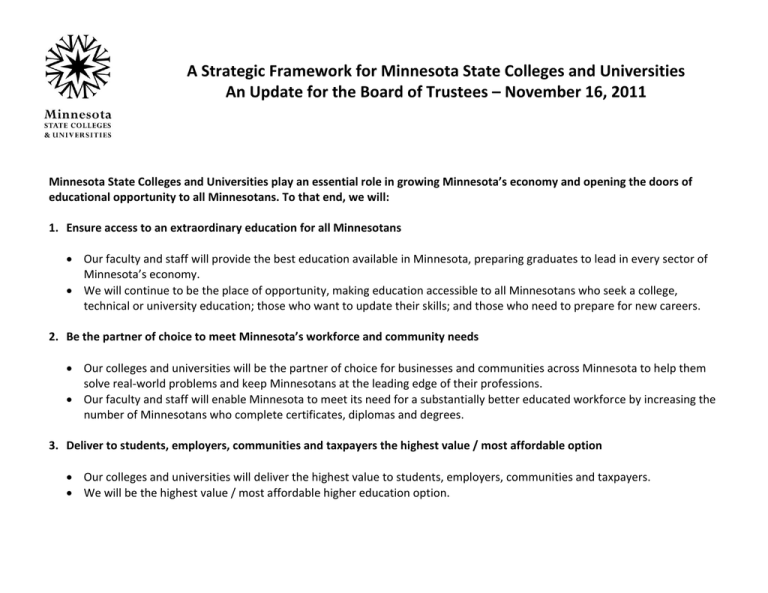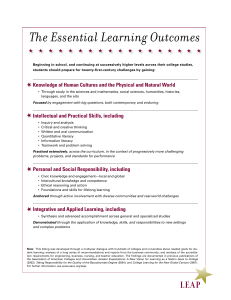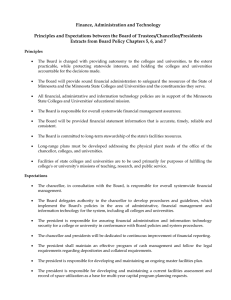A Strategic Framework for Minnesota State Colleges and Universities
advertisement

A Strategic Framework for Minnesota State Colleges and Universities An Update for the Board of Trustees – November 16, 2011 Minnesota State Colleges and Universities play an essential role in growing Minnesota’s economy and opening the doors of educational opportunity to all Minnesotans. To that end, we will: 1. Ensure access to an extraordinary education for all Minnesotans Our faculty and staff will provide the best education available in Minnesota, preparing graduates to lead in every sector of Minnesota’s economy. We will continue to be the place of opportunity, making education accessible to all Minnesotans who seek a college, technical or university education; those who want to update their skills; and those who need to prepare for new careers. 2. Be the partner of choice to meet Minnesota’s workforce and community needs Our colleges and universities will be the partner of choice for businesses and communities across Minnesota to help them solve real-world problems and keep Minnesotans at the leading edge of their professions. Our faculty and staff will enable Minnesota to meet its need for a substantially better educated workforce by increasing the number of Minnesotans who complete certificates, diplomas and degrees. 3. Deliver to students, employers, communities and taxpayers the highest value / most affordable option Our colleges and universities will deliver the highest value to students, employers, communities and taxpayers. We will be the highest value / most affordable higher education option. I. Ensure access to an extraordinary education for all Minnesotans. Our faculty and staff will provide the best education available in Minnesota, preparing graduates to lead in every sector of Minnesota’s economy. An extraordinary education is one that prepares graduates for work, life, and citizenship. It creates graduates who are creative, innovative, and able to respond with agility to new ideas, new technologies, and new global relationships. Graduates should be able to lead their professions and adapt to the multiple careers they will have over their lifetimes. Graduates should have the ability to think independently and critically; be able to resourcefully apply knowledge to new problems; proactively expect the unexpected, embrace change and be comfortable with ambiguity; and be able to communicate and work effectively across cultural and geographic boundaries. An extraordinary education is assessed not by looking at the quality of our freshmen, but by looking at the quality of our graduates: their capacities and skills, the rate at which they pass accreditation exams, secure employment, or are prepared for advanced degree programs. Graduates must have more than the skills needed to begin work - they must have the agility to adapt to the four or more careers that they are likely to have over their lifetimes including careers that don’t even exist today. Be the place of opportunity, making education accessible to all Minnesotans who seek a college, technical, or university education; those who want to update their skills; and those who need to prepare for new careers. We must say to every Minnesotan, we have a place for you. We must be the place of hope and opportunity serving all Minnesotans who seek a college, technical, or university education as well as workers seeking to update their skills or prepare for new careers. Access means that students with all kinds of backgrounds, experiences, and levels of preparation are welcome and will be served by one of our colleges or universities. Access means that we believe in the potential of all students – not only those in the top 10 percent of their high school class. We are committed to developing the potential of all learners. We take at-risk students and help them succeed. To serve all Minnesotans means that students have access to instruction and programs in ways that meet their needs, including the needs of working adults and students in greater Minnesota. Access means that college is affordable for students from families of modest financial means. II. Be the partner of choice to meet Minnesota’s workforce and community needs. Our faculty and staff will enable Minnesota to meet its need for a substantially better educated workforce by increasing the number of Minnesotans who complete certificates, diplomas, and degrees and by increasing the skills and capacities of our graduates. Minnesota needs a substantially better educated workforce for our state to be competitive in the global economy. Our colleges and universities are the institutions of higher education that will meet this critical state need. It’s more than just increasing the number of graduates; it’s increasing the skills and capabilities of our graduates so they are better prepared for the jobs of the future. Our colleges and universities will be the partner of choice for businesses and communities across Minnesota to help them solve real world problems and keep Minnesotans at the leading edge of their professions. Partner of choice for business and communities means that Businesses and communities turn to our colleges and universities because we are the conveners who can bring together all the parties who need to work together to solve the problem. We don’t have to wait until we are asked to help; we have on-going partnerships that make us an inextricable part of the on-going conversation. We listen from within and let our partners define their needs. Expand the reach of our customized training programs by building a state-wide network that will serve firms with similar needs. Bring together cross-campus, multidisciplinary teams to address key issues in ways that leverage the diverse skills that exist across our system. Scale up local solutions to become state-wide strategies. We know we’re on the right track when businesses in communities across the state have our colleges and universities on their speed dial. I. Ensure Access to an Extraordinary Education for all Minnesotans Project 1. Redesign the classroom experience and curriculum to create signature learning experiences such as project-based, and/or active, and/or problem-based learning. Prepare master teachers who will facilitate learning in this way. 2011-2012 Discussion and consultation with students, faculty, chief academic officers, deans, and presidents 2012-2013 Begin implementation in colleges and universities 2. Develop thoughtful measures of learning outcomes and deliver programs that enable graduates to meet those standards. Align with national standards, accreditation standards, and workforce needs. Discussion and consultation with students, faculty, chief academic officers, deans, and presidents Begin implementation in colleges and universities 3. Increase access to baccalaureate degrees by enabling students at two-year colleges to complete a MnSCU baccalaureate degree without relocating. Engage our seven universities to expand “university centers” at the two-year colleges and at other sites. Forge a metro plan Implement the metro plan Forge plans for other regions of the state 4. Partner with communities traditionally underserved by higher education to improve college readiness, recruitment, and student success. Create a welcoming and supportive campus environment, faculty and staff competencies, and student support services for all students to succeed. Deepen existing partnerships Identify best practices and deploy them across the system Work with P-20 Council, DOE, and Strive Initiative to reduce the achievement gap Develop measurable outcomes Continue to implement best practices and reduce the achievement gap Incorporate measurable outcomes into executive performance evaluation (III.7) 5. Increase collaboration among faculty across our colleges and universities to create the best possible courses and learning experiences that can be shared across the system. (e.g. create a common liberal arts core; reform Mn Transfer Curriculum) Redesign our e-education strategy (pure and blended courses) to improve quality, enhance learning, increase access, increase the number of students served, and reduce the costs of course development and delivery. Create a model that enables courses to be shared across colleges and universities. Discussion and consultation with students, faculty, chief academic officers, deans, presidents, and staff Identify alternative models Forge consensus on new models Begin implementation 6. Develop and implement regional and state-wide academic plans that will meet workforce needs and enrollment demand, but reduce unnecessary duplication and use existing infrastructure more efficiently. (E.g., increase space utilization; move to 12-month calendar where feasible; move more instruction online; right-size campuses to better align resources with student demand and needs). HOLD until II.3 is completed Devise academic plans based on workforce needs assessment (II.3 & II.4) II. Be the Partner of Choice to Meet Minnesota’s Workforce and Community Needs Project 1. Better align P-12 with post-secondary education. Partner with the Department of Education to increase the number of high school graduates who are college ready; inform students earlier whether they are college ready; and move college-ready students into higher education sooner. Increase student aspirations for higher education and provide information on the programs that best match a student’s skills and passions. Align high school exit competence and college entrance expectations. Increase pathways to college (e.g. new strategies for PSEO, College in the Schools, and applications to higher education). 2011-2012 Collaborate with DOE Commissioner to develop plans and models Discussion and consultation with faculty, chief academic officers, deans, and presidents 2012-2013 Collaborate with DOE Commissioner and others to bring about the adoption and implementation of the new models Expand partnerships between MnSCU colleges and universities and high schools 2. Dramatically increase retention, transfer and completion. Dramatically reduce time to completion. Set ambitious completion targets for each college and university. Identify high-impact practices for student success and bring them to scale state-wide. Simplify programs and program pathways. Eliminate barriers to transfer of credit. Create clearer and easier pathways for degree laddering within MnSCU and with other institutions. Improve remedial education programs so that students who are not yet college ready achieve college readiness faster. Engage students, faculty, and staff to identify best practices and deploy them across the system Establish 2, 3, 4, and 5-year goals for each college and university for increases in retention; reduction in time to completion; increases in number of certificates, associate, and baccalaureate degrees awarded. Continue implementation of the Smart Transfer Plan to significantly improve transferability of credit Integrate with I.4 (above) Implement best practices at the colleges and universities Incorporate goals into executive performance evaluation (III.7) 3. Partner with DEED, GWDC, regional economic development agencies, and businesses to identify the workforce needs going forward and forge region-by-region, sector-by-sector plans (e.g. health professions, manufacturing, financial services, bio-tech, etc.) to meet those needs. Design and complete the regional, sector-bysector workforce needs assessment Colleges and universities create regional and state-level academic plans to meet workforce needs (See I.6.) Expand Minnesota FastTRAC through partnerships to increase the workforce skills of workers Leverage Perkins consortium-related efforts to develop academic career pathways for workers Identify best practices for adult learners to update skills and prepare for new careers Colleges and universities continue to implement Expand customized training programs and identify shared solutions across the state Continue to implement 4. Collaborate with DEED, workforce centers, businesses, and other agencies to enable more people to more easily update skills and prepare for new careers. 5. Expand customized training and scale up local solutions to assist businesses in other regions of the state. III. Deliver to Students, Employers, Communities, and Taxpayers the Highest Value / Most Affordable Option by Designing the Minnesota State Colleges and Universities System of the Future Project 1. Collaborate with presidents and cabinet to re-structure the Leadership Council to improve consultation, increase the sharing of information and best practices, and advance the strategic framework. 2011-2012 2012-2013 Implement 2. Strengthen and expand the Campus Service Cooperative to substantially reduce administrative overhead costs in human resources, finance, financial aid, purchasing, payroll, and information technology services. Identify priorities, incentives and accountabilities in human resources, finance, financial aid, purchasing, payroll, IR, and IT services Set implementation plan, benchmarks, and milestones to be met Begin to implement priority projects Continue to expand the Campus Service Cooperative 3. Strengthen the MnSCU financial model to develop a long-term, sustainable financial strategy to ensure access to an extraordinary education for all Minnesotans and to meet Minnesota’s workforce and community needs. Create incentives to enhance costeffectiveness, increase quality, promote collaboration and cooperation, and drive desired outcomes. Specify outcomes that need to be achieved to realize the strategic framework Analyze the current allocation formula to identify incentives and disincentives in the formula vis-a-vis the outcomes to be achieved Analyze the current and possible future approaches to funding shared services including those in the system office Identify proposed modifications to the allocation formula and other financial and budgeting strategies to align them with the desired outcomes Begin consultation with Leadership Council, faculty, staff, and Board Reach consensus on the policy and administrative changes that should be made Implement the policy and administrative changes for FY2014 4. Create a long-term capital plan that advances the long-term academic plan HOLD until 2012-2013 Craft the plan 5. Redesign the MnSCU organizational structure and processes. Clarify what responsibilities reside with the campuses; what activities should be carried out in a coordinated fashion; what should be done by the system office. Clarify the roles of presidents in supporting the system while leading their campuses. Discussion and consultation with faculty, staff, chief academic officers, deans, and presidents Implement the policy and administrative changes for FY2014 6. Improve executive performance evaluation to advance the strategic framework. Align performance evaluation process and metrics with strategic framework Simplify performance evaluation process Establish specific diversity goals Implement November 2011



